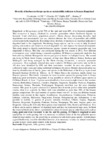Use este identificador para citar ou linkar para este item:
http://www.alice.cnptia.embrapa.br/alice/handle/doc/1007221| Título: | Diversity of herbaceous forage species as sustainability indicator in Kenyan Rangeland. |
| Autoria: | CAVALCANTE, A. C. R.  GLUECKS, I. V.   OGILLO, B. P.   AKUMU, J.   |
| Afiliação: | ANA CLARA RODRIGUES CAVALCANTE, CNPC; Ilona Victoria Gluecks, Veterinary - VSF Suisse, Kenya; Bryan Peter Ogillo, Scientific Researcher Kari, Kiboko, Kenya; Jeremiah Akumu, Veterinary - VSF Suisse, Kenya. |
| Ano de publicação: | 2013 |
| Referência: | In: ANNUAL MEETING BRAZILIAN SOCIETY OF ANIMAL SCIENCE, 50., 2013, Campinas. The integration of knowledge in animal production: abstracts. Campinas: SBZ, 2013. Abstract 6GFB. |
| Conteúdo: | Rangelands in Kenya make up for 70% of the land and hosts 60% of its livestock population. This ecosystem is largely inhabited by nomadic pastoralists whose livelihood depents on livestock. Land subdivision, population growth, climate change, devastating droughts, land degradation and unsustainable land use practices threaten the future of pastoralist and wildlife conservation in the rangelands. Knowledge about diversity of species is an important indicator of degraded land in the rangelands. Monitoring forage species can be a way to help livestock owning communities and farmers to recover degraded land and improve the natural environment. This study aimed to identify main herbaceous species present in nomadic pastoralist and farm rangelands in Kenya. This trial was conducted during the wet season in 2012. Two different environments were visited during a research expedition. Ol Maisor a commercial ranch that has been utilizing Holistic Management for the past years is located in Laikipia County. The second one being in Merti, Isiolo County composed of four sites: Bisan Biliquo, Bulesa, Korbesa and Malkagalla and being managed by the Merti Grazing Committee, a nomadic pastoralist community. Five randomly selected sites were visited in Ol Maisor and twelve sites in Merti. All sites were identified by GPS and their coordinates recorded. In each site, plants were collected to make exsiccates using traditional techniques (by press). Botanic characterization was done by identification of family, genus and species at the Herbarium of the Kenya Agricultural Research Institute (KARI) in Kiboko. At Ol Maisor Ranch the dominant family found was Poaceae (grasses). This family represents the most important species for grazing lands in Kenya indicating good and healthy rangelands. It was possible to identify 51 different grass species at Ol Maisor Ranch. At least, 13 genera were identified at least seven to eight times in this location: Aristida, Bothrichloa, Cenchrus, Cynodon, Digitaria, Eragrostis, Harpchne, Panicum, Paspalum, Pennisetum, Setaria, Themeda, Trachypogon. Eragrostis tenuiflora was the most abundant species. This grass is a poor constituent of pasture once livestock prefers other more palatable species when it is available. In Merti, forb were identified as more than 50% of the botanic pasture composition. The total number of species found were 67. At least ten different botanic families were present in this region: Acanthaceae, Amaranthaceae, Combretaceae, Fabaceae, Labiatae, Liliaceae, Malvaceae, Onagraceae, Poaceae, Polygonaceae and Sollanaceae. It was possible to identify 11 genera of grasses: Aristida, Cenchrus, Chloris, Cyprus, Digitaria, Eleusine, Eragrostis, Hyperenia, Panicum, Sehima, Tetrapogon. The most frequent genus was Eragrostis. Among the forb only three genera were important: Sida, Barelia and Ocimum. Two of these can be used as indicator of degraded lands and they were present in large areas. In Merti the observed biodiversity shows a potential for various livestock species other than cattle such as sheep, goats and other ruminants to use the land for grazing, Ol Maisor?s rangeland is more appropriate for cattle grazing, but it is necessary to monitor some of the less palatable species found in large density and the possibility to substitute it with better grass species. In both places a good biodiversity could be identified, however, it is necessary to carry out annual monitoring in order to keep weeds under control in the Kenyan rangelands. |
| Thesagro: | Forragem Identificação Árvore forrageira Erva daninha |
| NAL Thesaurus: | Eragrostis Herbaceous plants Kenya Pastoralism Rangelands Grasses Weeds forbs |
| Palavras-chave: | Quênia Planta herbácea |
| Tipo do material: | Resumo em anais e proceedings |
| Acesso: | openAccess |
| Aparece nas coleções: | Resumo em anais de congresso (CNPC)  |
Arquivos associados a este item:
| Arquivo | Descrição | Tamanho | Formato | |
|---|---|---|---|---|
| CNPC2013Diversity.pdf | 64,33 kB | Adobe PDF |  Visualizar/Abrir |









